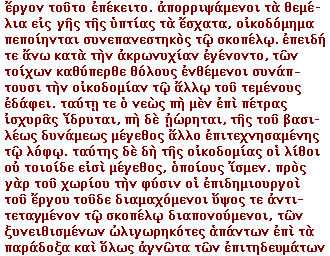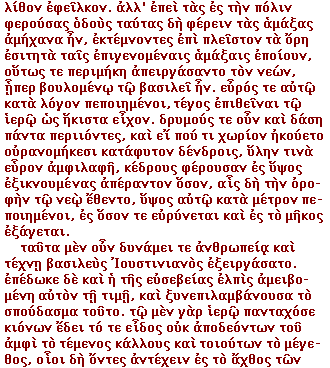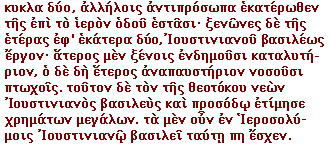by Procopius of Caesarea, DE AEDIFICIIS, 558 C.E.
PERI TON TOU DESPOTOU
IOUSTINIANOU KTISMATON
LOGOS E
PROCOPII CASESARIENSIS OPERA OMNIA,
De Aedificiis, ed. Jacob Haury, 1964.
CONCERNING THE EMPEROR
JUSTINIAN'S BUILDINGS
BOOK 5, Chapter 6
PROCOPIUS, VOL. VII: BUILDINGS.
Transl. H. B. Dewing, Harvard Univ. Press, 1980.













6. Such were the works of the Emperor Justinian in Cilicia. And in Jerusalem he dedicated to the Mother of God a shrine with which no other can be compared. This is called by the natives the 'New Church'; and I shall explain of what sort it is, first making this observation, that this city is for the most part set upon hills; however these hills have no soil upon them, but stand with rough and very steep sides, causing the streets to run straight up and down like ladders. All the other buildings of the city chance to lie in one group, part of them built upon a hill and part upon the lower level where the earth spreads out flat; but this shrine alone forms an exception. For the Emperor Justinian gave orders that it be built on the highest of the hills, specifying what the length and breadth of the building should be, as well as the other details. However, the hill did not satisfy the requirements of the project, according to the Emperor's specifications, but a fourth part of the church, facing the south and the east, was left unsupported, that part in which the priests are wont perform the rites. Consequently those in charge of this work hit upon the following plan. They threw the foundations out as far as the limit of the even ground, and then erected a structure which rose as high as the rock. And when they had raised this up level with the rock, they set vaults upon the supporting walls, and joined this substructure to the other foundation of the church. Thus the church is partly based upon living rock, and partly carried in the air by a great extension artificially added to the hill by the Emperor's power. The stones of this substructure are not of a size such as we are acquainted with, for the builders of this work, in struggling against the nature of the terrain and labouring to attain a height to match the rocky elevation, had to abandon all familiar methods and resort to practices which were strange and altogether unknown. So they cut out blocks of unusual size from the hills which rise to the sky in the region before the city, and after dressing them carefully they brought them to the site in the following manner. They built wagons to match the size of the stones, placed a single block on each of them, and had each wagon with its stone drawn by forty oxen which had been selected by the Emperor for their strength. But since it was impossible for the roads leading to the city to accomodate these wagons, they cut into the hills for a very great distance, and made them passable for the wagons as they came along there, and thus they completed the length of the church in accordance with the Emperor's wish. However, when they made the width in due proportion, they found themselves quite unable to set a roof upon the building. So they searched through all the woods and forests and every place where they had heard that very tall trees grew, and found a certain dense forest which produced cedars of extraordinary height, and by means of these they put the roof upon the church, making its height in due proportion to the width and length of the building.
These things the Emperor Justinian accomplished by human strength and skill. But he was also assisted by his pious faith, which rewarded him with the honour he received and aided him in this cherished plan. For the church required throughout columns whose appearance would not fall short of the beauty of the building and of such a size that they could resist the weight of the load which would rest upon them. But the site itself, being inland very far from the sea and walled about on all sides by quite steep hills, as I have said, made it impossible for those who were preparing the foundations to bring columns from outside. But when the impossibility of this task was causing the Emperor to become impatient, God revealed a natural supply of stone perfectly suited to this purpose in the near by hills, one which had either lain there in concealment previously, or was created at that moment. Either explanation is credible to those who trace the cause of it to God; for while we, in estimating all things by the scale of man's power, consider many things to be wholly impossible, for God nothing in the whole world can be difficult or impossible. So the church is supported on all sides by a great number of huge columns from that place, which in colour resemble flames of fire, some standing below and some above and others in the stoas which surround the whole church except on the side facing the east. Two of these columns stand before the door of the church, exceptionally large and probably second to no column in the whole world. Here is added another colonnaded stoa which is called the narthex, I suppose because it is not broad. Beyond this is a court with similar columns standing on the four sides. From this there lead doors to the interior which are so stately that they proclaim to those walking outside what kind of sight they will meet within. Beyond there is a wonderful gateway and an arch, carried on two columns, which rises to a very great height. Then as one advances there are two semi-circles which stand facing each other on one side of the road which leads to the church, while facing each other on the other side are two hos- pices, built by the Emperor Justinian. One of these is destined for the shelter of visiting strangers, while the other is an infirmary for poor persons suffering from diseases. And the Emperor Justinian endowed this Church of the Mother of God with the income from a large sum of money. Such were the activities of the Emperor Justinian in Jerusalem.
These things the Emperor Justinian accomplished by human strength and skill. But he was also assisted by his pious faith, which rewarded him with the honour he received and aided him in this cherished plan. For the church required throughout columns whose appearance would not fall short of the beauty of the building and of such a size that they could resist the weight of the load which would rest upon them. But the site itself, being inland very far from the sea and walled about on all sides by quite steep hills, as I have said, made it impossible for those who were preparing the foundations to bring columns from outside. But when the impossibility of this task was causing the Emperor to become impatient, God revealed a natural supply of stone perfectly suited to this purpose in the near by hills, one which had either lain there in concealment previously, or was created at that moment. Either explanation is credible to those who trace the cause of it to God; for while we, in estimating all things by the scale of man's power, consider many things to be wholly impossible, for God nothing in the whole world can be difficult or impossible. So the church is supported on all sides by a great number of huge columns from that place, which in colour resemble flames of fire, some standing below and some above and others in the stoas which surround the whole church except on the side facing the east. Two of these columns stand before the door of the church, exceptionally large and probably second to no column in the whole world. Here is added another colonnaded stoa which is called the narthex, I suppose because it is not broad. Beyond this is a court with similar columns standing on the four sides. From this there lead doors to the interior which are so stately that they proclaim to those walking outside what kind of sight they will meet within. Beyond there is a wonderful gateway and an arch, carried on two columns, which rises to a very great height. Then as one advances there are two semi-circles which stand facing each other on one side of the road which leads to the church, while facing each other on the other side are two hos- pices, built by the Emperor Justinian. One of these is destined for the shelter of visiting strangers, while the other is an infirmary for poor persons suffering from diseases. And the Emperor Justinian endowed this Church of the Mother of God with the income from a large sum of money. Such were the activities of the Emperor Justinian in Jerusalem.